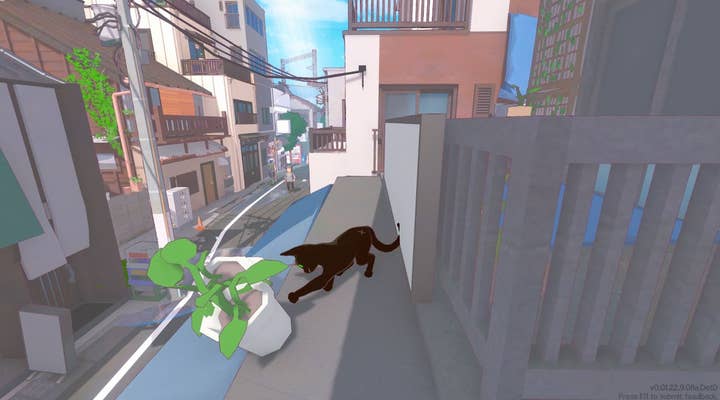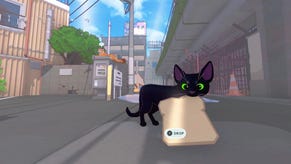Little Kitty, Big City: How a former Half-Life dev’s game for his kids became an overnight success
Double Dagger founder Matt Wood takes us through the development of his smash hit feline adventure
Without a doubt, one of May's surprise hit games has been Little Kitty, Big City. Released on May 9, the wholesome adventure game about a cat looking for its way home has been massively successful, selling over 100,000 units within the first 48 hours of release, and garnering over a million plays on Game Pass. As of this writing, it also continues to hold strong among the top five downloadable titles on the Nintendo eShop.
The remarkably warm reception has been equally surprising to its developer, the newly formed Double Dagger Studio, helmed by Matt T. Wood.
Wood, whose game development career began at 3D Realms in the late '90s, spent over 16 years at Valve before deciding to break away and form his own company. Double Dagger Studio arose from his desire to challenge himself in new ways as a game developer.
"It was a super tough decision," he says. "Valve was a really great place to be, and going out on your own was a huge risk to take, but it was worth it to be able to have new challenges and try new things. I wanted to bring something new to the industry, work with some new people, all these different things."
Going out on his own also gave Wood more free time to spend with his three kids, who acted as sounding boards for his game ideas. He'd done several prototypes and experiments, but one idea that seemed to strike a chord with all of them was a game concept where you played as a cat.

"I made a really quick prototype, made a video, put it online, and it kind of blew up," he says. "I was like, 'Wow, people seem to really be interested in this. Maybe I should focus on it more.' That was kind of the start of it."
Expressing oneself as a cat, doing things as a cat, and seeing things through the eyes of a cat were interesting concepts, but the next question that arose was what exactly the player was supposed to do as a cat? What could be the game's objective?
"The concept could be anything," says Wood. "You can go in a direction that might be interesting game mechanics-wise, might be interesting technology-wise, but it could take away from the feel, immersion and spark of being a cat and connecting with people in that way.
"My main focus was to make sure that I could maintain and capture that spark and interest of playing as and relating to cats. When you watch videos on the internet about cats, that feeling that you get when you're playing with your own cat, just watching your cat – I wanted to make sure that existed."
Wood wanted the focus to be less on the design and more on player experience as well as the connections they made. Then, he needed to figure out the gateway based on that. "It took a while, experimenting and figuring out what is interesting, and how that translates into an interactive experience."
Early concepts for Little Kitty, Big City still had the titular cat exploring the city to find a way home, but with a stronger emphasis on survival, having to find food and resources and sleep at appropriate times. However, that gameplay style naturally brought with it certain aspects that Wood wanted to avoid.
"I realized that when people want to play or connect with a cat, the last thing they want is to have that cat struggle, fail, get hurt or be in distress," he says. "It's not that type of game. This is for fun and making people smile. It didn't take very long for me to realize I can't really make a good survival game interesting without putting the cat in danger. So I scrapped that."
"When people want to play or connect with a cat, the last thing they want is to have that cat struggle, fail, get hurt or be in distress"
Having worked on games like Half-Life 2 and Left 4 Dead, Wood definitely has experience with titles that put the player character in peril. However, he notes that when that character isn't a human, things are different.
"I can disassociate with all the things happening to humans in video games, them getting hurt or dying or whatever. It's no big deal," he says. "But you do that to animals, it's not cool anymore."
Keeping the kitty out of harm's way was imperative for Wood and his team, and they quickly learned that potential players shared their feelings. "As time went on… I had people reaching out to me, asking various questions. Parents especially – they'd say, 'We've played other cat games and the cat would get hurt, and we were really worried your game was going to be similar. We don't want that.' I would have to assure them that's not what we wanted the game to be.
"I really tried to focus on making a game that parents could play with their kids. That was a really important thing to me, to make a game that different ages could play together at the same time and enjoy. I want it to be an experience where everybody feels joy and they don't have to stress about anything. This is a positive game about the joy of playing as a cat. Not having the cat get hurt is super important."
As it is, the worst peril the kitty has to endure in the game is occasionally touching water or being gently carried out of a business by a disgruntled shopkeeper. Even if the cat should fall from a significant height, it will (as cats do) always land on its feet, no worse for wear. Instead of focusing on survival, the kitty gets to casually explore the city, interact with and help out all sorts of quirky animal characters, nuzzle the legs of passersby, knock potted plants off of high places, try and find find sunny spots for a quick nap, nibble on a fish here and there – typical kitty things.

Accurately simulating such a wide variety of catlike behavior in gameplay means getting the movement right. Judging from the feedback Wood received, he and his team succeeded – and not all of the feedback was from humans.
"I get videos and pictures of people's cats watching the gameplay because they're fascinated by the cat's movement," says Wood. "That was something I wanted to achieve but wasn't sure how to actually accomplish other than nailing the animations."
Thanks to animator Micah Breitweiser, they were able to do just that. "When I started working with Micah, she was able to create these animations that were so natural, more than I thought I could get out of this game," says Wood. "Now we just needed to focus more on accentuating those and bringing the animations more to the front so we can showcase her work more."
In fact, Breitweiser's animations for the kitty raised the bar so significantly that other aspects of the character were tweaked to better compliment them, such as how the cat turned or leaped onto ledges.
"Valve was a really great place to be, but I wanted to bring something new to the industry"
"We would go back and revisit those, and I would redo a lot of things to [improve them]," says Wood. "I went with a system where the spine would follow the head, so now when you turn, you're basically controlling the chest, and the head and everything else follows behind. You get very fluid turns and movements cats would do as they move around. The old way was, you move around, you're turning, and then you stop and immediately go back to idle [animation]. It's kind of jarring, but common in video games. But when you're looking up close at this cat that's beautifully animated and precise in a lot of ways, it suddenly feels not as good, so I started to invest in dynamic spine animation. I think it helped a lot with making things feel more natural and less like animation states."
The animation could be particularly tricky when it came to the kitty making jumps, giving the game some platformer elements. However, since the kitty wasn't your average platforming character, the team had to approach its animation differently.
"There's all these ideal jumping arcs, timings and stuff for platformers, and they work really well in those situations," says Wood, "but we were riding that line between trying to feel a little bit like a platformer but still grounding everything in as much reality as we could. Doing those really floaty jumps that a lot of platformers do, I tried it for a while and it just feels bad when you put it in a system like this where you're trying to do realistic animations and make things feel natural." Undoubtedly one of the biggest fears a fledging studio has is whether or not their debut title will be well-received by the gaming community. For Wood, he strove to keep his expectations tempered.
"You try your best to focus on all those playtests that you had where people would say good things, the good feedback you're getting," he says. "You have to find a balance between 'My game is going to tank because of X, Y and Z' and 'No, I've been through this before. I know what the focus is going to be on. I don't have to worry about these other things.' I think in the end, it didn't matter for a lot of those areas."
Wood was right, perhaps far more than he expected. As mentioned at the outset, Little Kitty, Big City became an overnight success.
"It was surprising," he says. "I had modest projections about what I was hoping to do by the end of the year, and we hit those pretty quickly. I'm really happy to hear and see that people are connecting with it and getting out of it what I hoped they would.
"The other thing that was surprising: I had no idea how well it would be received on Game Pass. I assumed it would fly under the radar, but I was getting emails and messages saying, 'I'm an Xbox player, I normally play racing games, but I tried out your game on Game Pass and really enjoyed it. Thank you for making it.' That's super cool."
Between the highly successful Stray in 2022, Little Kitty, Big City's recent meteoric rise, and Copycat coming out later this year, it seems like "cat simulator" games are becoming a hot commodity, and game developers are rising to meet demand. Wood finds himself fortunate that Little Kitty, Big City was able to get in on the ground floor.
"It feels like it's an introduction. 'Hey, you get to play as a cat.' The games that come out after won't be able to use that marketing point as much. It won't be as powerful."
As cat games become more common and less of a novelty, Wood notes that the challenge for developers will become finding ways to make future games in a similar vein unique from what came before.
"They have to do something more interesting, deeper," he says. "I think that there's a lot of potential in making games that you actually play as a cat that feels like a cat and not a cartoon character with a cat face and ears or as a human character that looks like a cat. It's just a normal platformer where you're just playing as a cat character. I think there's absolutely a lot of opportunity, focusing on an actual cat game, for sure. And I look forward to it."



